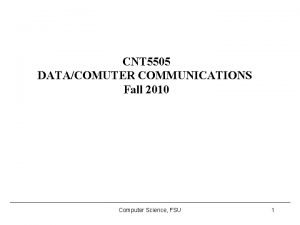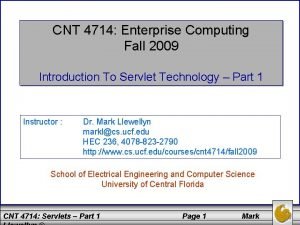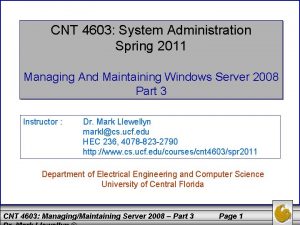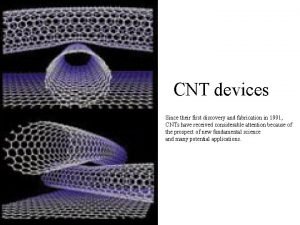Software Project in Computer Networks CNT 4104 Dr




















- Slides: 20

Software Project in Computer Networks CNT 4104 Dr. Janusz Zalewski Florida Gulf Coast University

ASP. NET – Active Server Pages

ASP. NET is a server-side technology for developing web applications based on the. NET Framework.

Terminology Reminder: web application – same as dynamic website.

• ASP. NET has been created in response to such technologies as CGI, PHP, etc. , that allow creating dynamic webpages • ASP. NET allows use of multiple languages (C#, VB, others) • ASP. NET pages are compiled, not interpreted

Essentially, ASP. NET requires using: • Windows, although. NET Framework has been ported to other operating systems, as well • Microsoft’s Internet Information Services (IIS) server (although a small server named Cassini exists for hobbyists)

• Microsoft SQL Server is also required, if one needs a webpage to interact with a database (required in any serious web development)

Technical details: • web pages are text files with. aspx extension • web files should be placed in the directory C: Inetpubwwwroot • files cannot be opened locally from Explorer, only via the web server • default. aspx is a default page


Structure of an ASP. NET page: • directives • code declaration blocks • code render blocks • ASP. NET server controls • server side comments • literal text and HTML tags.

Role of the directives: • control how the page is compiled • allow importing classes • specify page caching in a browser • assist in debugging. Directives start with <%@ and end with %> Example of a directive: <%@ Page Language=“C#” %>

Code declaration blocks help separate the application logic from HTML contents. The application logic defines variables, subroutines, functions, etc.

Example of a code declaration block: <script runat=”server”> void my. Sub() { // Code placed here } </script>

Code render blocks define inline code and inline expressions. Inline code render blocks execute one or more statements and are placed inside HTML code delimited by <% … %> Inline expression render blocks display values of variables/methods.

Example of a code render block: <% string Title=”text”; %> Example of inline expression render block: <%= Title %>

ASP. NET server controls • are central to every ASP. NET page • represent page’s dynamic elements • usually must reside within a <form runat=“server”> tag • fall into 3 categories: ASP. NET controls, HTML controls, and web user controls.

Server side comments allow including text, which will not be processed by ASP. NET. They are included in special type of brackets: <%-- comments go here --%>

Literal text and HTML tags provide the structure for presenting dynamic data, give a page the right format, which the browser can understand.

Sample code <%@ Page Language=”C#” %> <!DOCTYPE html PUBLIC ”-//W 3 C//DTD XHTML 1. 0 Strict//EN” ”http: //www. w 3. org/TR/xtml 1/DTD/html 1 -strict. dtd”> <HTML> <HEAD> <TITLE>Sample Page</TITLE> <SCRIPT runat=”server”> void Page_Load() { message. Label. Text = ”Hello World”; } </SCRIPT> </HEAD> <BODY> <FORM runat=”server”> <P> <ASP: Label id=”message. Label” runat=”server” /> <P> <%-- Declare title as string and set it --%> <% string Title=”From code render block”; %> <%= Tiltle %> </FORM> </BODY> </HTML>

Summary All of the dynamic portions of the web pages in ASP. NET are usually contained within code render blocks or controls located inside a tag: <form runat=”server”>
 A switch in a datagram network uses
A switch in a datagram network uses Basestore iptv
Basestore iptv Cap 4104
Cap 4104 Dpo 4104
Dpo 4104 Sans sec 555
Sans sec 555 Adapun cnt adalah
Adapun cnt adalah Cnt 4603 fsu
Cnt 4603 fsu Cnt 4714
Cnt 4714 Int sum = 0
Int sum = 0 Cnt servicio al cliente
Cnt servicio al cliente Cnt 4714
Cnt 4714 Cnt 4603
Cnt 4603 Cepima
Cepima Cnt discovery
Cnt discovery Cnt 4714
Cnt 4714 Cnt phones
Cnt phones Medžiagos tankis ppt
Medžiagos tankis ppt Organigrama cnt
Organigrama cnt Namas chandra
Namas chandra Process discriminants in software project management
Process discriminants in software project management Project evaluation in software project management
Project evaluation in software project management







































